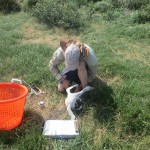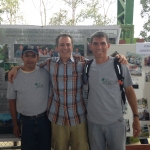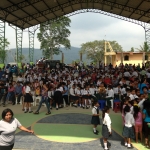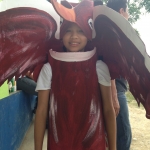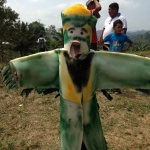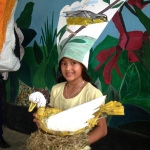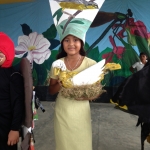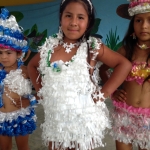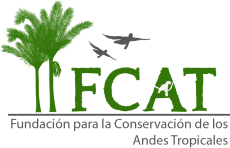Fall 2016
Another summer has come and gone – lab members have travelled far and wide for field work and conferences, and have now returned to New Orleans for the fall semester.
We are excited to welcome our two new Ph.D students, John Jones and Sarah Khalil!
John joined the lab with funding from a Louisiana Board of Regents Fellowship. He got an early start on research with a preliminary field experience with fairy wrens in Australia and Papua New Guinea this past summer. Now he is adjusting to the heat of New Orleans while preparing to conduct more field work in Papua New Guinea during the start of the spring semester.
Sarah is funded by an NSF Graduate Research Fellowship. She returned at the start of the summer from a field season in Kenya, finishing her research at Columbia University studying superb starlings. She later joined the IRES crew for a preliminary field season in Australia, and now is excited to be in New Orleans where she gets to escape the cold winters of New York.
Sam returned from the field in Australia, finishing her last field season while leading the NSF IRES crew. While down under, she was awarded best student oral presentation at the Queensland Ornithological Conference for her presentation on non-breeding season space use in male fairywrens.
Brock completed another field season in the northern Gulf, tracking a cohort of breeding brown pelicans while continuing long-term demographic surveys on Raccoon Island.
Erik returned from Papua New Guinea and spent the remainder of the summer digging into analyzing his data from the field season.
After finishing up their respective field seasons, the bird side of the lab all met up at the end of the summer in Washington D.C. for the North American Ornithological Conference (NAOC 2016). The lab was well represented at the conference – Sam presented work on how the environment influences sociality in fairywrens, Brock presented some of his preliminary findings, Erik presented his work on the White-shouldered fairy wrens, and John presented on his previous master’s work.
Luke and Jordan’s study “Negative frequency-dependent selection for rare genotypes promotes genetic diversity of a tropical palm” was accepted for publication in Ecology Letters (link to PDF)! Another paper on the “Diversity of palm communities at different spatial scales in a recently fragmented tropical landscape” (Browne and Karubian 2016) was published in the Palms – emblems of tropical forests special issue of the Botanical Journal of the Linnean Society. Luke finished up his last field season of his dissertation this summer with Tulane undergrad Mike Mahoney, hiked the Camino de Santiago in Spain, and presented at the Ecuadorian Ornithology Congress with colleagues from Ecuador.
In New Orleans, Zoë completed a pilot project examining neutral genetic differentiation of 8 populations across Ecuador on both sides of the Andes. She is now preparing her prospectus and plans to be in the field during the spring semester to do extensive sampling of Oenocarpus bataua along both sides of the Andes.
Jordan had an active summer, with international travel to Australia where he helped to provide training to our current group of NSF-funded IRES students and to Ecuador, where he gave a presentation at the V Ecuadorian Ornithology Congress in Zamora. He also spent time working with Renata Ribeiro and Stephanie McClelland studying mockingbirds right here in New Orleans. He published a paper (Karubian et al. 2016) with Luke Browne, Malinda Chambers (a former Tulane undergrad and 4+1 MS student), and local Ecuadorian residents in the Botanical Journal of the Linnean Society.
Read MoreSpring 2016
Spring has come yet again, which means a few things here in New Orleans – Jazz Fest and Karubian lab website updates!
Huge congrats to Jenny Hazlehurst for defending her dissertation and publishing one of her chapters – Nectar robbing impacts pollinator behavior but not plant reproduction – in Oikos (Hazlehurst and Karubian 2016)! Jenny is now continuing on as a post-doc at UC Davis.
Sam Lantz and Jordan published the first chapter of Sam’s thesis in Auk (Lantz and Karubian 2016), focusing on adventitious molt in fairywrens. This paper was highlighted on the Audubon blog. In the summer she headed back to Australia to lead the NSF IRES crew.
Luke Browne along with Ecuadorian colleagues and Jordan, traveled to Colombia for the World Palm Symposium to present work on the effects of habitat loss on palm tree diversity in Ecuador. He spent the rest of the summer completing another field season in Ecuador. While spending the fall and spring semesters in Washington DC / College Park, Maryland, he presented on conservation and research in the Chocó rainforests of Ecuador to the AAAS Biodiversity Affinity group in Washington DC.
Erik Enbody advanced to candidacy in the fall and received grants from the National Geographic Young Explorer’s Grant, Animal Behavior Society, and the Tulane Department of Ecology and Evolutionary Biology to continue his field work on white-shouldered fairy wrens in Papua New Guinea, where he spent his spring semester. Check out his blog from the field for more details and cool pictures!
Brock Geary advanced to candidacy in February and was awarded the Tulane Gunning Memorial Student Research Award, as well as winning a grant from the AOU to study brown pelican foraging behavior. He presented at the Louisiana Department of Wildlife and Fisheries Research Symposium and published 2 papers from his masters work: Movements and survival of juvenile reddish egrets Egretta rufescens on the Gulf of Mexico coast (Geary et al. 2015) and Measurements of Adult and Hatch-year Reddish Egrets (Kozcur etal. 2015).
Zoë Díaz-Martin received the Lewis and Clark Award for Field Exploration to do field research in Ecuador. She finished her coursework and decided on a dissertation topic, which includes studying patterns and drivers of genetic variation and differentiation in populations of Oenocarpus bataua on a landscape scale. This summer she will be staying on campus to complete a pilot study.
Meredith Williams and Emma Saltzberg received a grant from the Newcomb College Institute and Newcomb-Tulane College to study the northern Mockingbird in New Orleans with visiting MS student Stephanie McClelland.
Jordan, former post-doc Kym, and colleagues published a new paper on the genetic consequences of seed dispersal to sleeping trees by white-bellied spider monkeys (Karubian et al. 2015). Jordan and Sam Lantz also published original research on flamingos in the journal Zoo Biology with lead authorship by Nathan Frumkin, a former Tulane undergrad and 4+1 student. Nathan gathered the data for this article while taking the course ‘Experimental Animal Behavior’ at Tulane.
The Lab received funding from the U.S. Fish and Wildlife Service’s ‘Neotropical Migratory Bird Conservation Act’ to purchase rainforest habitat in northwest Ecuador together with our in-country partners FCAT.
We are also very happy to welcome Sarah Khalil and John Jones as new PhD students to the lab, who will be starting in Fall 2016!
Read MoreSpring 2015
Another academic year has come and gone, and the lab is spread far and wide for the annual summer diaspora. Lab members are conducting research in Australia, Brazil, Colombia, Ecuador, Papua New Guinea, Peru, and points beyond while others continue their research closer to home in the city of New Orleans and the Gulf of Mexico’s barrier islands. Since the last update, the lab received 2 NSF Doctoral Dissertation Improvement Grants (DDIG), 1 NSF Graduate Research Fellowship (GRF), and been recommended for 1 NSF International Research Experience for Students (IRES) grant and 1 NSF EAGER grant. We have published papers in Heredity (Browne et al. 2015), Journal of Avian Biology (Durães Ribeiro et al. 2015), and Journal of Field Ornithology (Walter et al. 2014). Details are as follows:
Jordan and family are heading to Ecuador in May to teach EBIO 3780 ’Tropical Field Biology & Conservation’, a field course in Ecuador. Jordan will be presenting at the PALMS conference in Montenegro Colombia in June, and the Ecological Society of America conference in Baltimore MD in August.
Jenny received an NSF DDIG to expand her work in nectar robbery and hummingbird pollination and an EEB Departmental Fellowship to help with writing up in the Fall. This summer, she will be radio tracking hummingbirds in Peru.
Sam received the 2014/15 Best Teaching Assistant award for Department of Ecology & Evolutionary Biology as well as the prestigious Tulane Woodrow Wilson Teaching Fellowship in the School of Science & Engineering for the 2015/16 year. She will be in Australia this summer, gathering data on fairy-wren condition and habitat use outside Brisbane.
Luke, former post-doc Kym Ottewell, and Jordan published the paper ‘The short-term genetic consequences of habitat loss and fragmentation for the neotropical palm Oenocarpus bataua’ in Heredity (Browne et al. 2015). Luke was also awarded DDIG funding from the NSF to continue work on the impacts of habitat fragmentation on gene flow in the Oenocarpus system. He will be helping to teach EBIO 3780, presenting at the PALMS conference in Montenegro Colombia in June, and conducting research in Ecuador and in the lab this summer.
Erik received a grant from the American Museum of Natural History for his work on the evolution of sexual dimorphism in white-shouldered fairy-wrens, and presented a poster at the American Ornithologists Union (AOU) on his work. He is heading to Papua New Guinea for another field season.
Brock received grants from the Animal Behavior Society, the Wilson Ornithological Society, and the Louisiana Sea Grant for his research on brown pelican foraging ecology, and also presented a poster at AOU. He will be tracking GPS-equipped pelicans in the Gulf of Mexico this summer.
Zoe completed her first year of graduate school in high style, and received a NSF Graduate Research Fellowship to boot! She will be helping to teach EBIO 3780, participating in an OTS course in Costa Rica, and conducting pilot field research in Ecuador this summer.
Read MoreFall 2014
Autumn is here, and most lab members have returned from the far ends of the earth to New Orleans for fall semester at Tulane. It was quite the summer, and things show little sign of slowing down in the fall. Since the last update, we received a grant from the National Science Foundation for work on white-shouldered fairy-wrens in Papua New Guinea, and had publications come out in Evolution, Canadian Journal of Zoology, and Journal of Tropical Ecology.
Luke Browne was in Ecuador, collecting data on palm dispersal and demography at Bilsa Biological Station and mentoring research by Malinda Chambers, now a +1 MS student in the lab, and John Bailey Cox, a Tulane undergrad. Luke is remaining down in Ecuador through the end of the year to study forest fragments, as described below.
Brock Geary worked with Dr. Scott Walter to successfully deploy 14 GPS tracking devices on brown pelicans in the Gulf of Mexico, with support from the National Geographic Society. He is now working through the trove of data he collected. Brock has been developing a collaboration to link pelican movements to distributions of the fish they forage upon with Dr. Kevin Purcell, a new friend of the lab!
Erik Enbody conducted research on white-shouldered fairy-wrens at our study site in Papua New Guinea’s Milne Bay Province, and gathered additional data from Western, and Enga Provinces. With support from the Disney Worldwide Conservation Fund, he and Max Alliaga to helped to produce a short film on this project and worked with resident Serena Ketaloya to provide a series of training workshops and educational events for local communities.
Zoe Diaz-Martin spent time in Ecuador becoming familiar with the field site, helping Luke, and also collecting seed trap data with local resident researcher Domingo Cabrera. Zoe is now busy taking classes and settling into life in New Orleans.
After wrangling pelicans over the summer, post-doc Dr. Scott Walter is currently in Ecuador, working with Luke and our friends at FCAT. They are leading a research team consisting of local residents, university students, and PhD level researchers. The team is assessing effects of forest fragmentation on biodiversity, with focused studies of many taxa including amphibians, mammals, understory bird communities, nocturnal birds, beetles, orchid bees, bird parasites, soil bacteria, palm species diversity, and forest structure. This project is supported by US Fish & Wildlife Service, Disney Worldwide Conservation Fund, CREOi, and Conservation, Food & Health Foundation.
Over the summer, Jordan Karubian caught up with Sam and the IRES team in Australia, and then visited Erik in Papua New Guinea. He traveled to the Animal Behavior Society meeting in August, as well as the American Ornithologists Union annual meeting in September, where he presented along with Sam, Erik and Brock. Jordan and friend of the lab Renata Ribeiro are currently seeking students for Tropical Field Biology and Conservation (EBIO 378), a summer field course in Ecuador! Stay tuned for our next update, in early 2015.
Read MoreSpring 2014
Spring semester has come to an end, and the Lab is preparing to scatter to the far corners of the globe for research and conservation activities! Lots of exciting news from these past few months, and lots of good things to look forward to.
Brock and Scott are already in the midst of field work with Brown Pelicans on the Gulf Coast, deploying GPS tracking units, and researching chick survival. Brock received a SeaGrant to bring on undergrad Lily Armstrong-Davies as a field assistant.
Jenny received a grant from the Animal Behavior Society to continue work on nectar robbery and hummingbird pollination this summer. She’ll be heading out to the field mid to late summer to Peru, radio telemetry equipment in hand!
Erik is preparing for three months in Papua New Guinea to study White-shouldered Fairy Wrens, funded in part with a grant he won from the American Ornithologists Union. He will be returning to the existing field site in Milne Bay, and Jordan will join him for a couple of weeks of galavanting through PNG’s little-known Western Province.
Sam advanced to PhD candidacy, and recently got back from a trip to WSU doing hormone analysis with the Schwabl lab. She and Tulane students Nicole Moody, Alex Gulachenski, and Roxy Franta are gearing up to head down under for the summer for the third year of our NSF-funded IRES project in Australia. Congrats to both Nicole and Alex for receiving Newcomb grants to supplement the summer research!
The Karubian and Derryberry labs teamed up on outreach by doing a workshop with middle school girls as part of the Tulane Girls in Science and Technology program (GIST) and by volunteering with kindergarteners from Kipp NOLA primary.
Luke also advanced to PhD candidacy this past Spring! He’s leaving soon for a 6 month field excursion to Ecuador where he will continue his work on pollen and seed dispersal of Oenocarpus. He will be joined in the field by Tulane undergrads Malinda Chambers and John Bailey Cox, who were awarded Newcomb and Taylor grants, respectively. A few of some videos from last summer were featured on a nature documentary website here and here.
The lab also received new grants from the Conservation, Food and Health Foundation and Tulane’s Center for Latin American Studies for work on fragments in Ecuador, and produced one new publication on patterns of amphibian diversity in Ecuador (Jongsma et. al 2014)
Nathan Frumkin successfully completed his honors thesis on Northern Mockingbirds, and was awarded the Cagle Prize and the Honors Scholar Prize. We are thrilled that Nathan will be remaining in the lab next year for a 4 + 1 Masters, to continue work on mockingbirds. With collaborators Renata Duraes Ribeiro and Elizabeth Derryberry, the lab received a grant from the Morris Animal Foundation to study how Northern Mockingbirds in New Orleans may be impacted by environmental lead.
We are happy to welcome incoming PhD student Zoe Diaz-Martinez into the lab! She will be starting in the fall semester and will be working on the seed dispersal project in Ecuador.
Jordan is looking forward to spending some Q.T. with the fairy-wrens this summer. He will be visiting Sam and the IRES crew in Australia’s Northern Territory before dropping in on Erik in Papua New Guinea. He will be back in the US in time to attend the Animal Behavior Society meeting in August.
Last but definitely not least, a hearty congratulations to our collaborator and friend Monica Gonzalez, Director of FCAT, for winning the prestigious Whitley Prize for her conservation work in Ecuador. Be sure to check out the short film on her work narrated by Sir David Attenborough – congratulations Monica!
Read MoreWinter 2013 – 14
It’s been a busy winter break and start of the semester for the Karubian lab! First off, we’d like to welcome Roxanne Franta (4+1 MS student) and this year’s NSF IRES fellows Alex Gulachenski and Nicole Moody to the lab.
In December, Jordan took a trip to Ecuador to attend FCAT’s second annual Environmental Fair in La Y de la laguna, in the Mache-Chindul Reserve. With the theme of ‘Migratory Bird Conservation’, the fair included poetry competitions, a migratory bird costume exhibition, and gowns made of recycled material. The event was attended by over 1200 local residents. Here are a few pictures from the event:
Though it’s only January, the Karubian lab has already started preparing for upcoming field seasons. Jenny has been applying to grants to fund her field season in Peru this summer, while simultaneously working up a manuscript on nectar production and hummingbird pollination of an Andean plant species and refining her lobster costume for Mardi Gras! Brock and Scott are eagerly awaiting the arrival new batch of GPS transmitters to track Brown Pelican movement this year, while continuing work on analyzing the population genetic structure of Brown Pelicans on the Gulf Coast. Luke is planning on defending his prospectus this spring and head off to Ecuador for field work this summer.
Sam has spent the winter break in Australia continuing field work on Red-backed Fairy-wrens, where they are finally breeding. Erik has recently finished genotyping White-shouldered Fairy-wrens captured from his work during the summer of 2013 in Papua New Guinea. He is working on setting up a new field site for 2014 and is looking for assistants to join him in the field. See the following link for more info: Field assistants in Papua New Guinea.
On the publishing front, check out some recent articles from the Karubian lab:
2014
Karubian, J. and R. Durães. Impacts of mating behavior on plant-animal seed dispersal mutualisms: a case study from a Neotropical lek-breeding bird. In Sexual Selection: Insights from the Neotropics (eds. R. Macedo and G. Machado). Elsivier Press. Pp. 365-390. PDF
2013
Carrasco, L., Berg, K. S., Litz, J., Cook, A. and J. Karubian. 2013. Avifauna of the Mache-Chindul Reserve, northwest Ecuador. Neotropical Ornithology 24: 331-324. PDF | Appendix
2013
Walter, S.T., M.R. Carloss, T.J. Hess, G. Athrey, and P.L. Leberg. 2013. Brown Pelican movement patterns and population structure. Condor 115:788-799. PDF
2013
Walter, S.T., M.R. Carloss, T.J. Hess, and P.L. Leberg. 2013. Hurricane, habitat degradation, and land loss effects on Brown Pelican nesting colonies. Journal of Coastal Research 29:187-195. PDF
Read More


